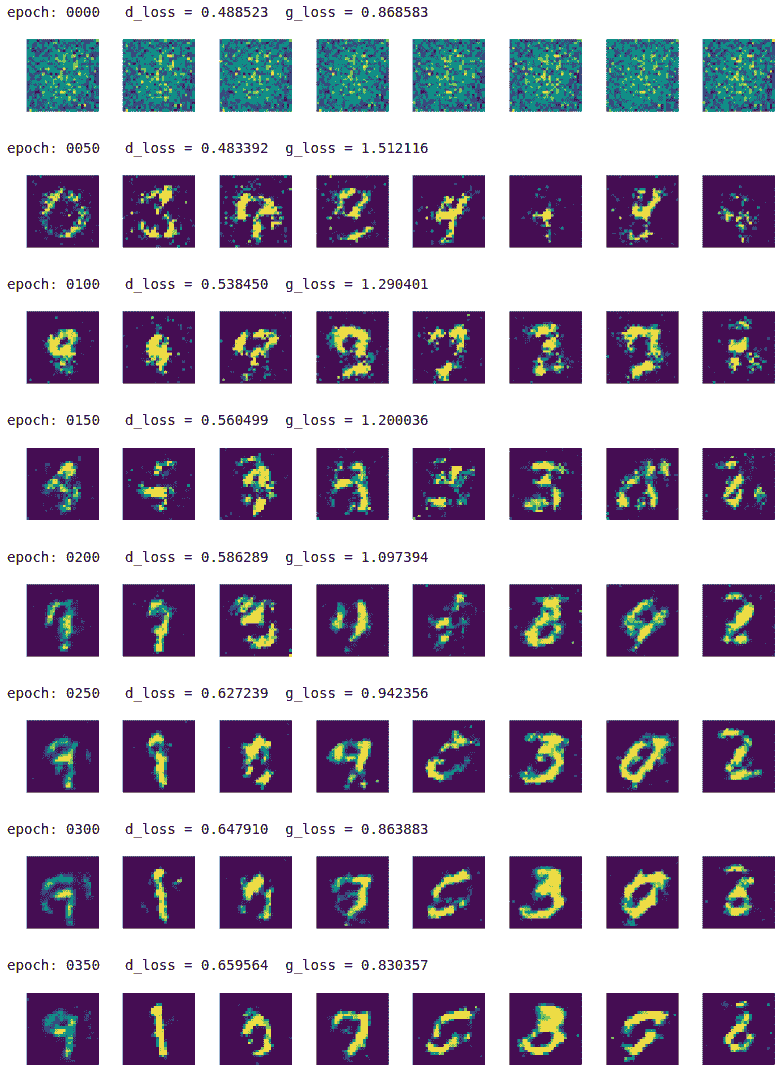使用 Keras 的简单的 GAN
您可以按照 Jupyter 笔记本中的代码ch-14a_SimpleGAN。
现在让我们在 Keras 实现相同的模型:
- 超参数定义与上一节保持一致:
# graph hyperparameters
g_learning_rate = 0.00001
d_learning_rate = 0.01
n_x = 784 # number of pixels in the MNIST image
# number of hidden layers for generator and discriminator
g_n_layers = 3
d_n_layers = 1
# neurons in each hidden layer
g_n_neurons = [256, 512, 1024]
d_n_neurons = [256]
- 接下来,定义生成器网络:
# define generator
g_model = Sequential()
g_model.add(Dense(units=g_n_neurons[0],
input_shape=(n_z,),
name='g_0'))
g_model.add(LeakyReLU())
for i in range(1,g_n_layers):
g_model.add(Dense(units=g_n_neurons[i],
name='g_{}'.format(i)
))
g_model.add(LeakyReLU())
g_model.add(Dense(units=n_x, activation='tanh',name='g_out'))
print('Generator:')
g_model.summary()
g_model.compile(loss='binary_crossentropy',
optimizer=keras.optimizers.Adam(lr=g_learning_rate)
)
这就是生成器模型的样子:
Generator:
_________________________________________________________________
Layer (type) Output Shape Param #
=================================================================
g_0 (Dense) (None, 256) 65792
_________________________________________________________________
leaky_re_lu_1 (LeakyReLU) (None, 256) 0
_________________________________________________________________
g_1 (Dense) (None, 512) 131584
_________________________________________________________________
leaky_re_lu_2 (LeakyReLU) (None, 512) 0
_________________________________________________________________
g_2 (Dense) (None, 1024) 525312
_________________________________________________________________
leaky_re_lu_3 (LeakyReLU) (None, 1024) 0
_________________________________________________________________
g_out (Dense) (None, 784) 803600
=================================================================
Total params: 1,526,288
Trainable params: 1,526,288
Non-trainable params: 0
_________________________________________________________________
- 在 Keras 示例中,我们没有定义两个判别器网络,就像我们在 TensorFlow 示例中定义的那样。相反,我们定义一个判别器网络,然后将生成器和判别器网络缝合到 GAN 网络中。然后,GAN 网络仅用于训练生成器参数,判别器网络用于训练判别器参数:
# define discriminator
d_model = Sequential()
d_model.add(Dense(units=d_n_neurons[0],
input_shape=(n_x,),
name='d_0'
))
d_model.add(LeakyReLU())
d_model.add(Dropout(0.3))
for i in range(1,d_n_layers):
d_model.add(Dense(units=d_n_neurons[i],
name='d_{}'.format(i)
))
d_model.add(LeakyReLU())
d_model.add(Dropout(0.3))
d_model.add(Dense(units=1, activation='sigmoid',name='d_out'))
print('Discriminator:')
d_model.summary()
d_model.compile(loss='binary_crossentropy',
optimizer=keras.optimizers.SGD(lr=d_learning_rate)
)
这是判别器模型的外观:
Discriminator:
_________________________________________________________________
Layer (type) Output Shape Param #
=================================================================
d_0 (Dense) (None, 256) 200960
_________________________________________________________________
leaky_re_lu_4 (LeakyReLU) (None, 256) 0
_________________________________________________________________
dropout_1 (Dropout) (None, 256) 0
_________________________________________________________________
d_out (Dense) (None, 1) 257
=================================================================
Total params: 201,217
Trainable params: 201,217
Non-trainable params: 0
_________________________________________________________________
- 接下来,定义 GAN 网络,并将判别器模型的可训练属性转换为
false,因为 GAN 仅用于训练生成器:
# define GAN network
d_model.trainable=False
z_in = Input(shape=(n_z,),name='z_in')
x_in = g_model(z_in)
gan_out = d_model(x_in)
gan_model = Model(inputs=z_in,outputs=gan_out,name='gan')
print('GAN:')
gan_model.summary()
gan_model.compile(loss='binary_crossentropy',
optimizer=keras.optimizers.Adam(lr=g_learning_rate)
)
这就是 GAN 模型的样子:
GAN:
_________________________________________________________________
Layer (type) Output Shape Param #
=================================================================
z_in (InputLayer) (None, 256) 0
_________________________________________________________________
sequential_1 (Sequential) (None, 784) 1526288
_________________________________________________________________
sequential_2 (Sequential) (None, 1) 201217
=================================================================
Total params: 1,727,505
Trainable params: 1,526,288
Non-trainable params: 201,217
_________________________________________________________________
- 太好了,现在我们已经定义了三个模型,我们必须训练模型。训练按照以下算法进行:
For each epoch:
For each batch: get real images x_batch
generate noise z_batch
generate images g_batch using generator model
combine g_batch and x_batch into x_in and create labels y_out
set discriminator model as trainable
train discriminator using x_in and y_out
generate noise z_batch
set x_in = z_batch and labels y_out = 1
set discriminator model as non-trainable
train gan model using x_in and y_out,
(effectively training generator model)
为了设置标签,我们分别对真实和假图像应用标签 0.9 和 0.1。通常,建议您使用标签平滑,通过为假数据选择 0.0 到 0.3 的随机值,为实际数据选择 0.8 到 1.0。
以下是笔记本电脑训练的完整代码:
n_epochs = 400
batch_size = 100
n_batches = int(mnist.train.num_examples / batch_size)
n_epochs_print = 50
for epoch in range(n_epochs+1):
epoch_d_loss = 0.0
epoch_g_loss = 0.0
for batch in range(n_batches):
x_batch, _ = mnist.train.next_batch(batch_size)
x_batch = norm(x_batch)
z_batch = np.random.uniform(-1.0,1.0,size=[batch_size,n_z])
g_batch = g_model.predict(z_batch)
x_in = np.concatenate([x_batch,g_batch])
y_out = np.ones(batch_size*2)
y_out[:batch_size]=0.9
y_out[batch_size:]=0.1
d_model.trainable=True
batch_d_loss = d_model.train_on_batch(x_in,y_out)
z_batch = np.random.uniform(-1.0,1.0,size=[batch_size,n_z])
x_in=z_batch
y_out = np.ones(batch_size)
d_model.trainable=False
batch_g_loss = gan_model.train_on_batch(x_in,y_out)
epoch_d_loss += batch_d_loss
epoch_g_loss += batch_g_loss
if epoch%n_epochs_print == 0:
average_d_loss = epoch_d_loss / n_batches
average_g_loss = epoch_g_loss / n_batches
print('epoch: {0:04d} d_loss = {1:0.6f} g_loss = {2:0.6f}'
.format(epoch,average_d_loss,average_g_loss))
# predict images using generator model trained
x_pred = g_model.predict(z_test)
display_images(x_pred.reshape(-1,pixel_size,pixel_size))
我们每 50 个周期印刷结果,最多 350 个周期:

该模型慢慢地学习从随机噪声中生成高质量的手写数字图像。
GAN 有如此多的变化,它将需要另一本书来涵盖所有不同类型的 GAN。但是,实现技术几乎与我们在此处所示的相似。